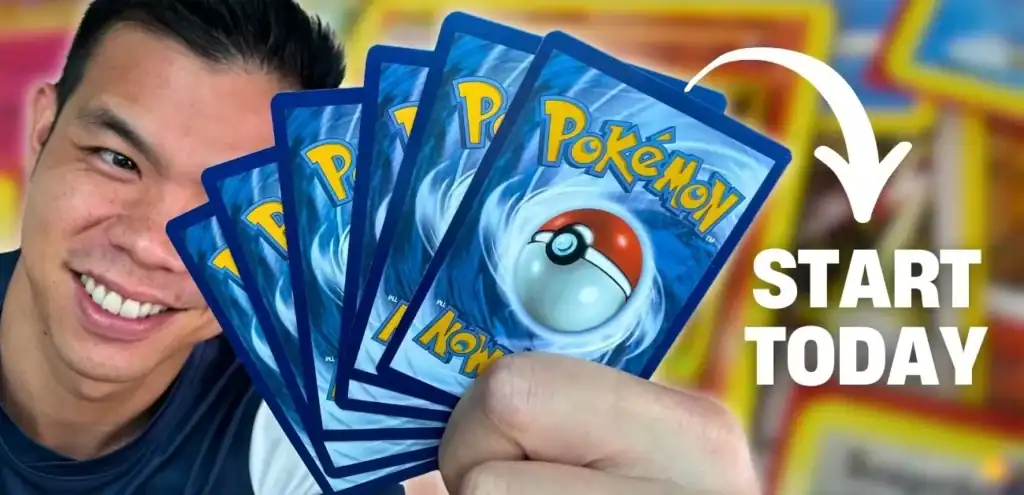The Pokémon Trading Card Game (TCG) is a tabletop game where two players battle each other using a unique 60-card deck of Pokémon, Energy, and Trainer cards. It’s easy to learn, full of strategy, and perfect for anyone who loves Pokémon.
This post may contain affiliate links. See our affiliate policy for more information.
Ever tried reading the official Pokémon TCG rulebook and walked away more confused than when you started? You’re not alone. The rulebook covers the basics of how to play Pokémon cards- but skips over the nuances that separate confident players from beginners asking, “Wait, can I evolve right now?”
This guide bridges that gap.
Whether you’re jumping into the Pokémon TCG for the first time, learning to play with your kids, or picking it up again after a 20-year hiatus (shoutout to my fellow 90s kids), we will make you feel confident going into your next battle.
We’ll cover every angle- from basic PTCG gameplay rules and how to read a Pokémon card, to setting up your first deck, competitive play, and even how to simplify the game for children.
Let’s learn how to play Pokémon cards.
Let’s level up.
What You’ll Learn
- Learn basic Pokémon TCG gameplay mechanics and start battling today. Download our PDF follow-along.
- Find out what you need to start playing Pokémon cards.
- Understand the different card types and what they do.
- For players interested in levelling up- build your first deck and get ready to compete in tournaments!
- For parents- learn how to play the Pokémon card game with your children!
- Pokémon TCG Gameplay Overview
- Essential Gear
- Types Of Pokémon Cards
- How To Play Pokémon Cards Step-By-Step
- 3 Ways To Win
- Special Conditions
- Beginner Pokémon TCG Mistakes
- Building Your First Pokémon TCG Deck
- Entering Your First Tournament
- Learn Faster With Pokémon TCG Live
- Parents Guide To Playing Pokémon Cards
- Playing Vs Collecting
- Conclusion
- FAQ
Pokémon TCG Gameplay Overview
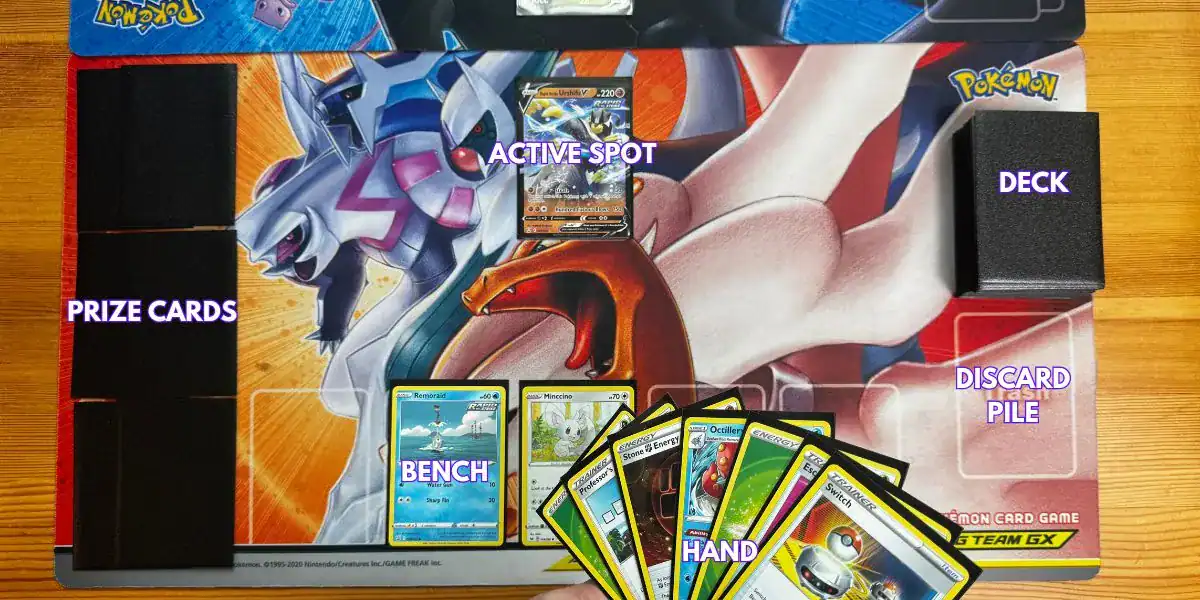
Here’s a quick introduction on how to play Pokémon cards:
That’s how to play Pokémon TCG in a nutshell. To start battling, you’ll need to gather a deck and other bits of gear. We’ll cover that next. Already have a deck? Skip ahead to our detailed step-by-step tutorial if you are ready to start playing.
Essential Gear
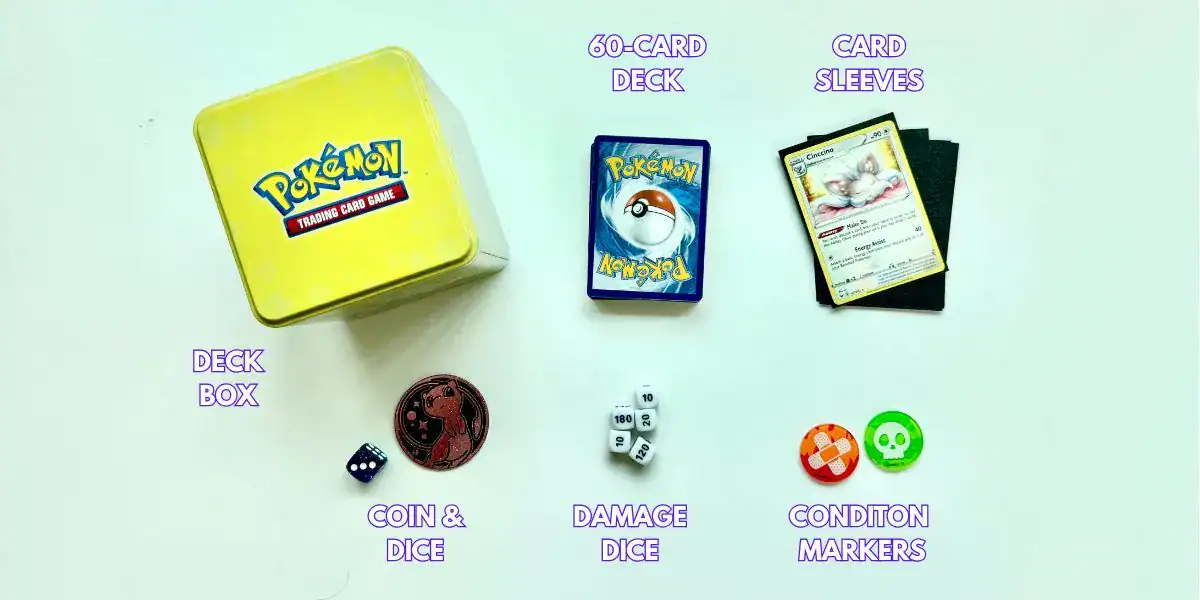
You’ll need to gather a few supplies to start playing Pokémon cards. Some bits are essential. Others are optional.
Here’s a complete list of things you need to play Pokémon cards:
| Item | Essential? | Tip |
|---|---|---|
| 60-card deck | Yes | We recommend buying a pre-built starter deck. These are designed for smooth gameplay. They take the stress out of deck-building and getting your card ratios correct, so you can focus on actually learning to play. |
| Dice or coins | Yes | You’ll need these for coin flips that are triggered by some card effects. These are included in starter decks. |
| Damage counters or damage dice | Yes | Used for keeping track of damage. These are included in starter decks. You can also print your own by going to our free PTCG resources. |
| Condition markers | Yes | Used for tracking special conditions. These are included in starter decks. |
| Playmat | No | Seriously helps with learning the PTCG zones: bench, discard, prize, etc. The artwork also looks dang cool. |
| Deck box | No | Loose cards in a plastic bag are quickly lost and damaged. A simple box keeps everything your deck in one place. |
| Card sleeves | No | Cards deteriorate rapidly with constant play. A $50 shiny card quickly crashes to $2 if it’s scuffed. Good-fitting sleeves for Pokémon cards measure 63 x 88mm to 66mm × 91mm. |
All of these items can be purchased individually. But costs mount up quick. We recommend starting with a boxed starter deck instead. These are convenient, include all the essentials, and offer the best value for money.
Gathered your gear? Next, we can start learning about the different cards in a Pokémon deck and what they do. If you already know the basics, feel free to skip ahead to the step by-step tutorial to start battling.
Types Of Pokémon Cards
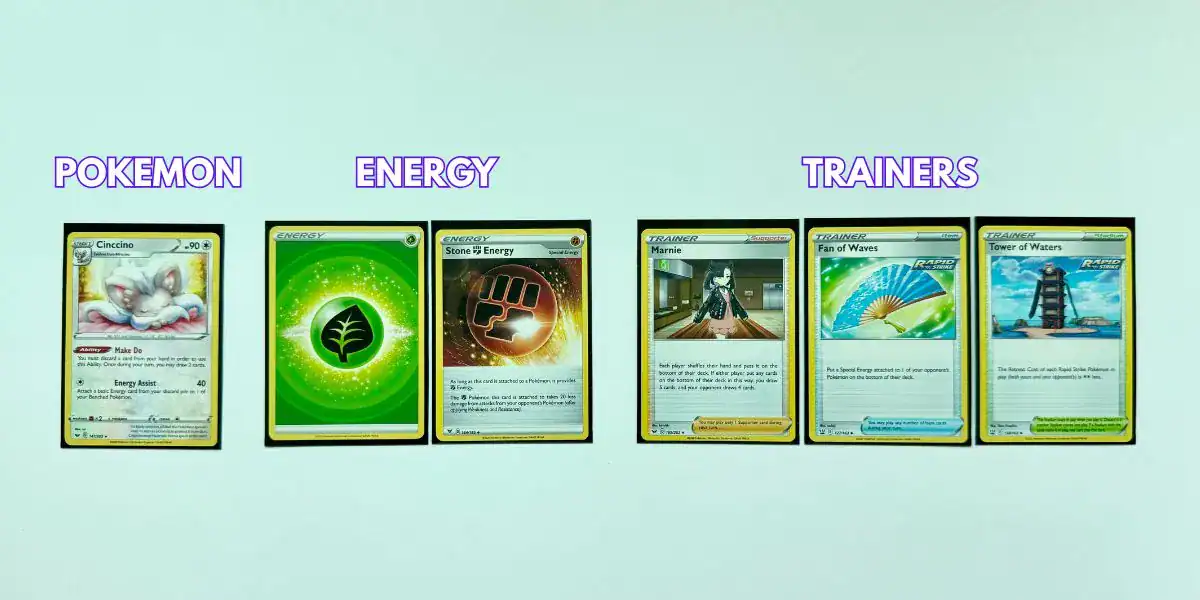
Learning how to play Pokémon cards requires you to know what your cards actually do. Don’t worry- I know the sheer variety of different cards can be intimidating. The good news? Each type of card in Pokémon TCG belongs to one of three categories:
1. Pokémon Cards
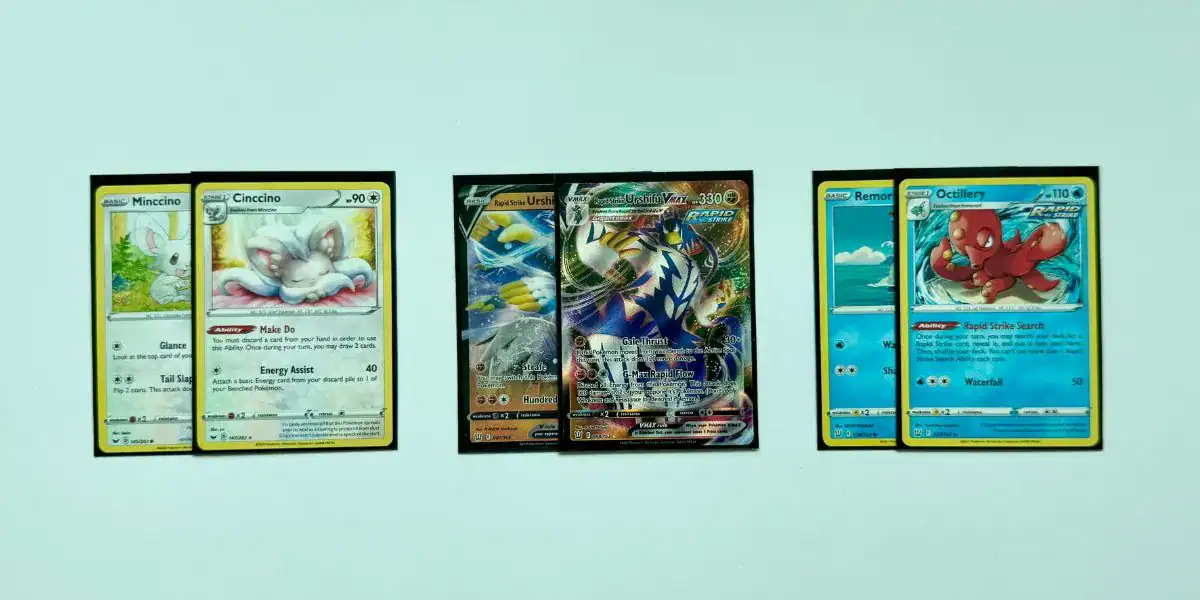
These are your fighters and the stars of the show. Beyond the cool artwork, each Pokémon card includes the following gameplay stat:
- Name.
- HP (short for Hit Points).
- Type (like Grass, Fire, Psychic, etc.).
- Evolution Stage (Basic, Stage 1, or Stage 2).
- Weakness & Resistance.
- Ability.
- Attacks.
- Retreat Cost.
You’ll find out what each stat does in the “Playing Pokémon Cards Step-By-Step” tutorial next.
2. Energy Cards
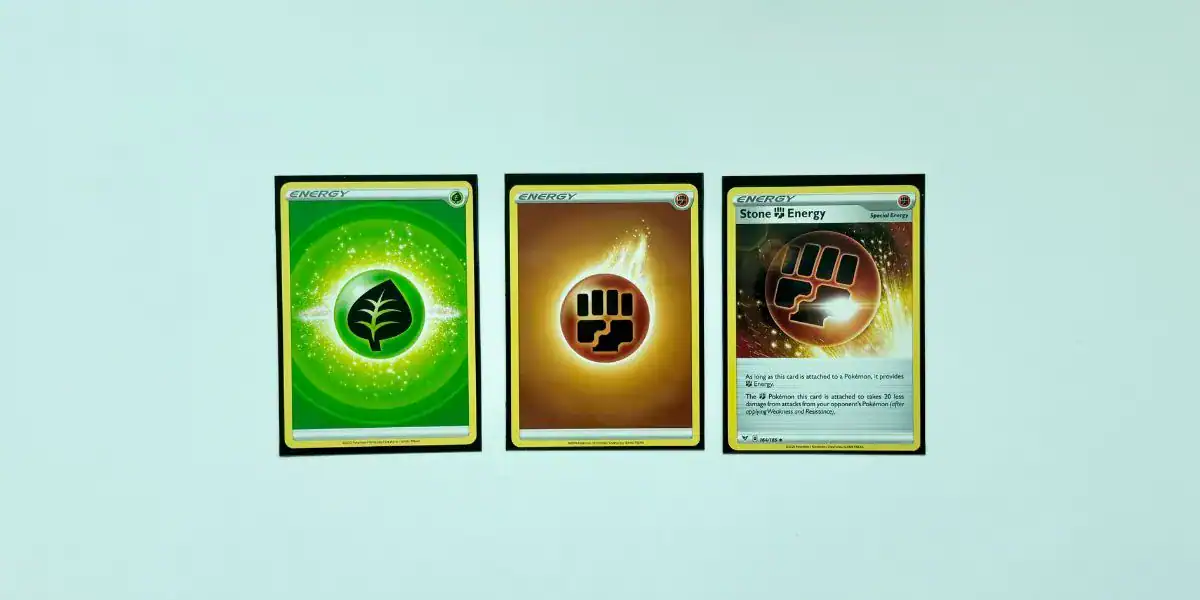
Energy cards are used to power up your Pokémon attacks. There are two types of Energy:
- Basic Energy. Grass, Fire, Water, etc. Each type is color-coded and associated with an elemental symbol.
- Special Energy. These have unique effects, super cool artwork, and “Special Energy” printed on the top-left corner.
3. Trainer Cards
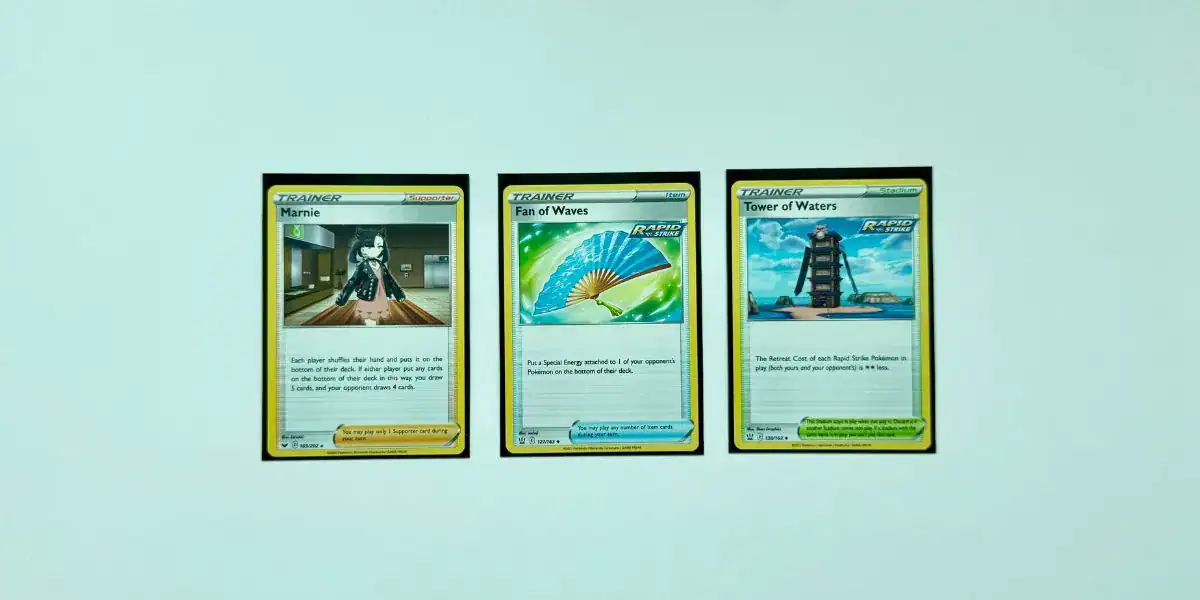
Trainers activate a variety of effects that help you win. They come in 3 types:
- Item cards. Play as many as you want per turn.
- Supporter cards. You can only play one per turn.
- Stadium cards. Stay on the battlefield where their effects are ongoing.
Items and Supporters are discarded after you use them. Stadiums stay in play until another Stadium card replaces them.
How To Play Pokémon Cards Step-By-Step
Ok. You have the gist of how the Pokémon TCG works, gathered your essential gear, and know what the different cards do. Now let’s get into the meat of it. This is where theory meets table- and where beginners either fall in love with the game or go “…what the frigg’?!”.
Here’s how to play a game of Pokémon cards step-by-step:
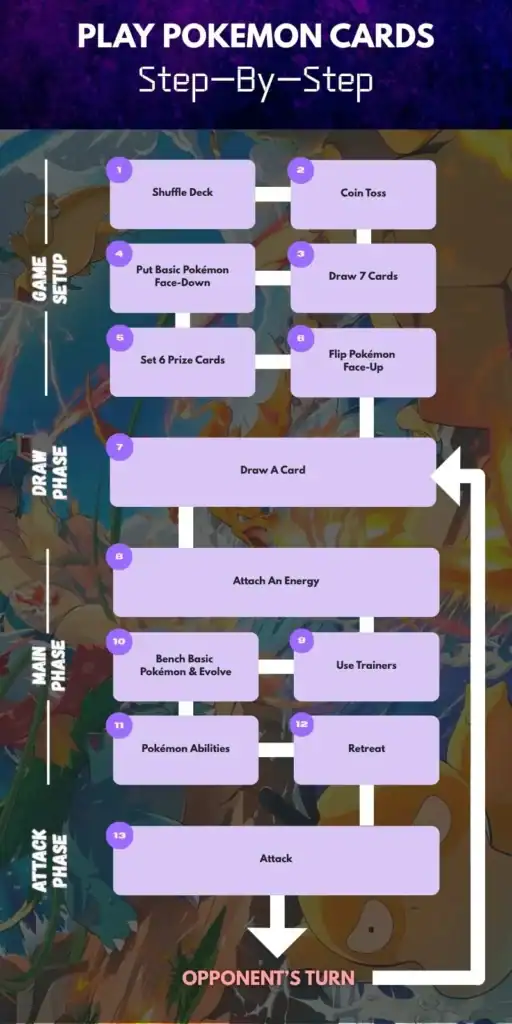
Tip: Download the mobile-friendly PDF of this infographic to follow along in your next battle.
Step 1: Shuffle Your Deck
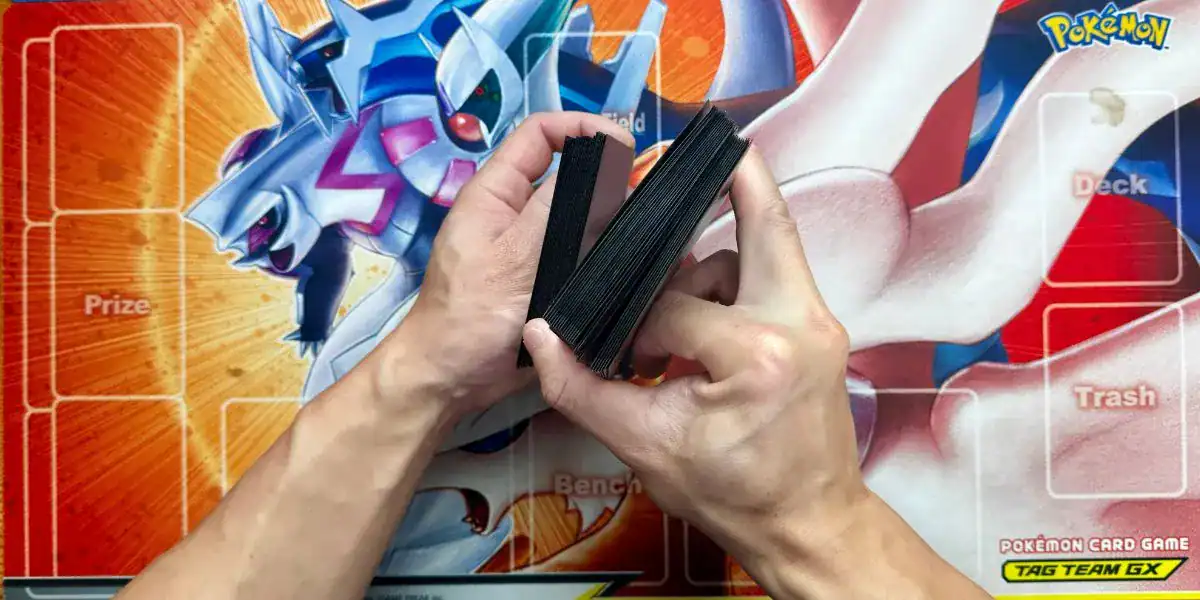
Seriously, shuffle. Nothing is worse than not being able to draw into your best Pokémon because they’re all clumped and hiding in your deck. It’s frustrating and a buzzkill.
Step 2: Coin Toss To Decide Who Goes First
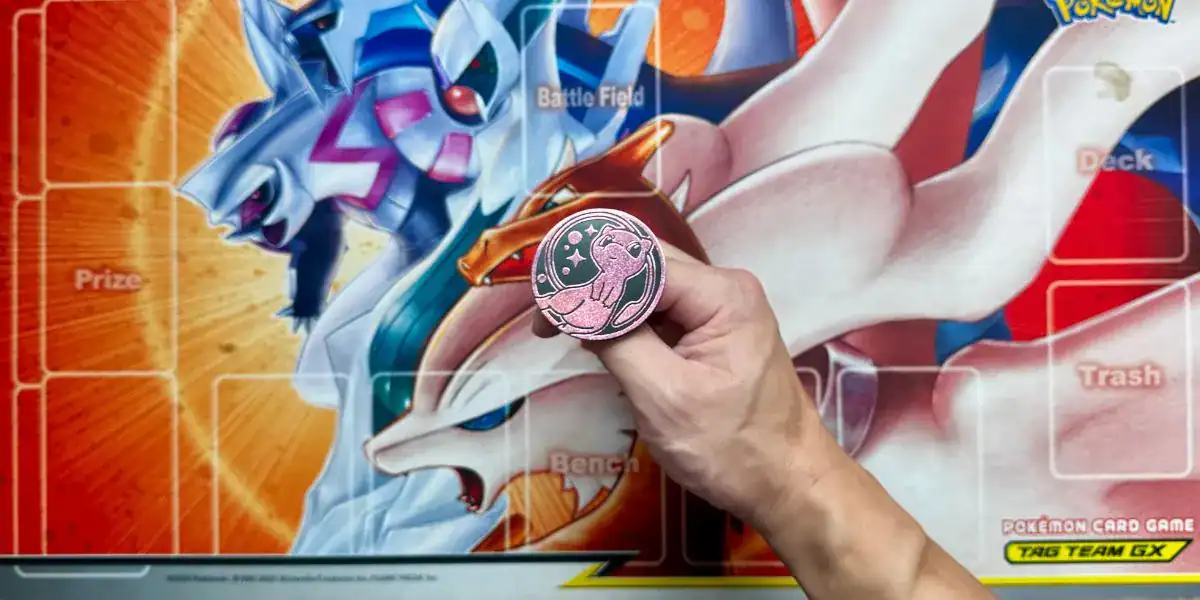
Flip a coin. The winner chooses to go first or second. No coin? Use a dice and call odds or evens.
Step 3: Draw 7-Card Opening Hand
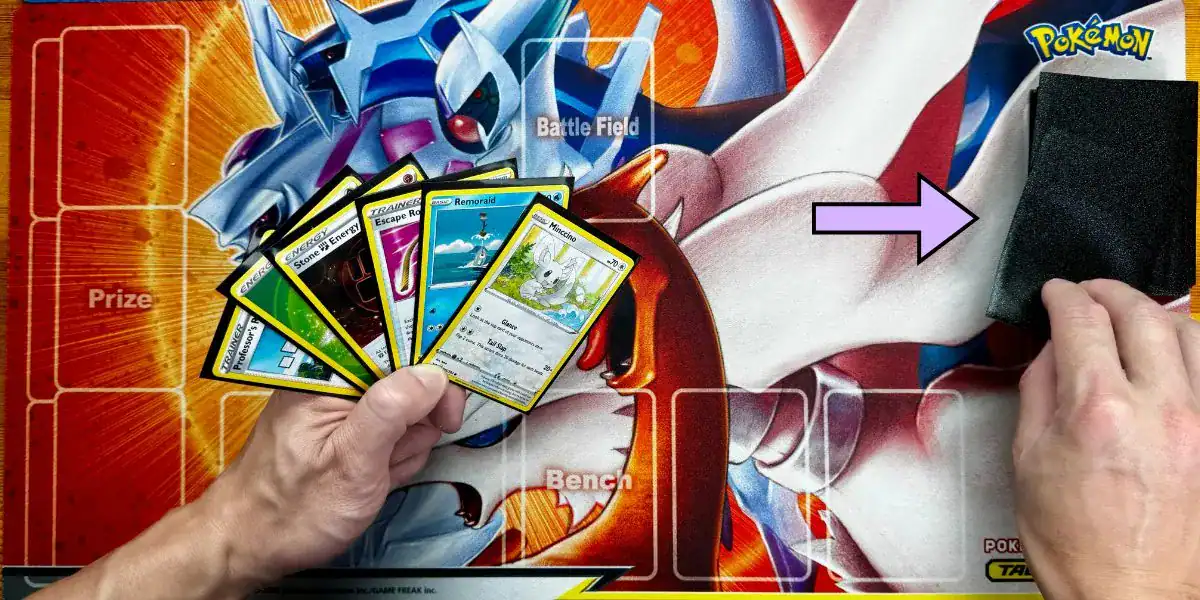
Drawing simply means taking the top card(s) from your deck and putting them into your hand.
Start the battle by drawing 7 cards- this is your opening hand (also called starting hand). Your hand is command central. It’s where you make all your plays. It’s important.
From this point onwards, there’s no limit to how many cards you can hold in your hand. And you always keep your hand hidden from your opponent unless another card effect says otherwise.
If you’re serious about winning, you’ll want to learn how to manage your hand like a Pro!
Step 4: Set Basic Pokémon Face-Down
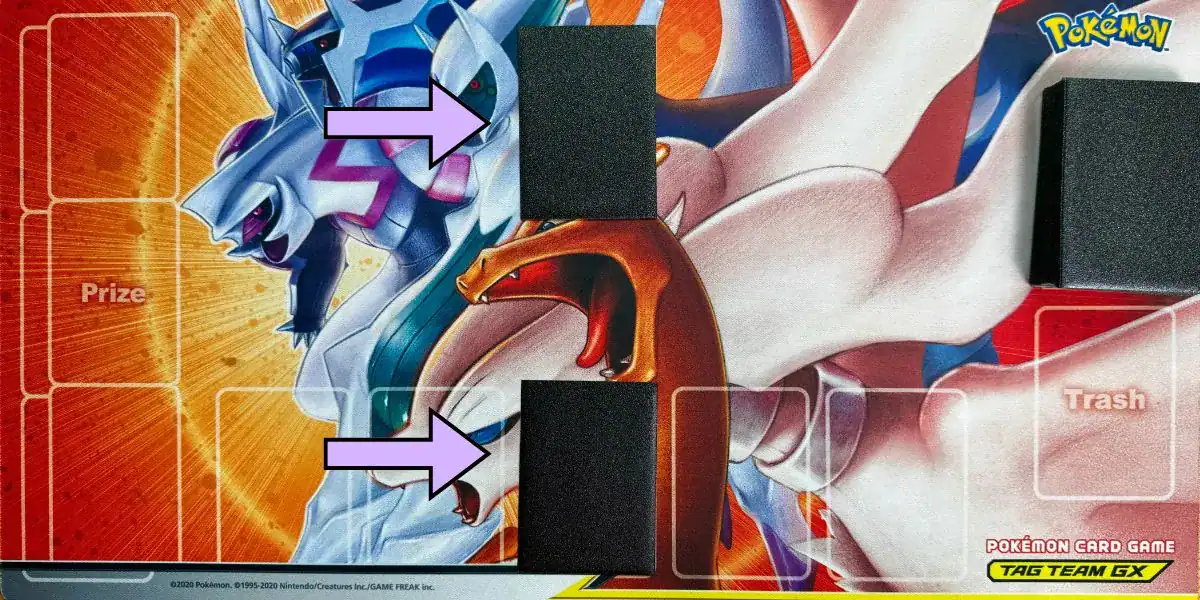
Look for a Basic Pokémon in your hand. These have the word “Basic” printed on the top-left corner. Place it face-down in your Active Position.
You can also place up to 5 more Basics on your bench. This is optional. But it’s always a good idea to have benched Pokémon as backup whenever you can.
Can’t find a Basic in your opening hand? That’s called a mulligan– shuffle your hand back into your deck and re-draw 7 cards. Your opponent can draw 1 extra card per mulligan.
Step 5: Set 6 Prize Cards
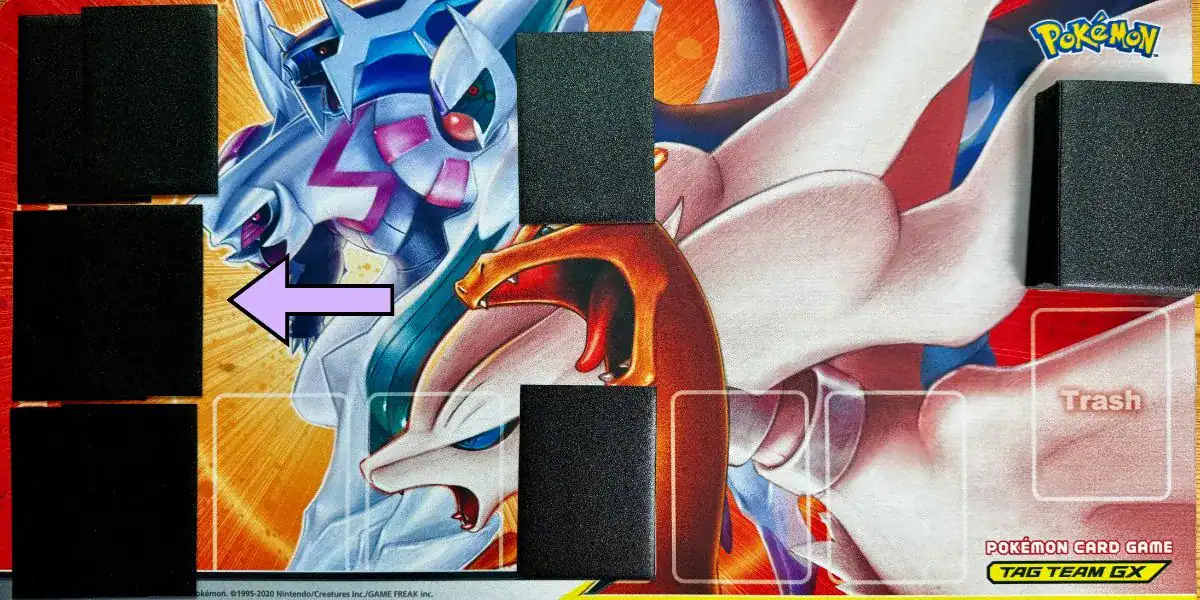
Take the next 6 cards from the top of your deck and place them face-down in the Prize zone. Do not look at your prizes.
Step 6: Flip All Pokémon Face-Up
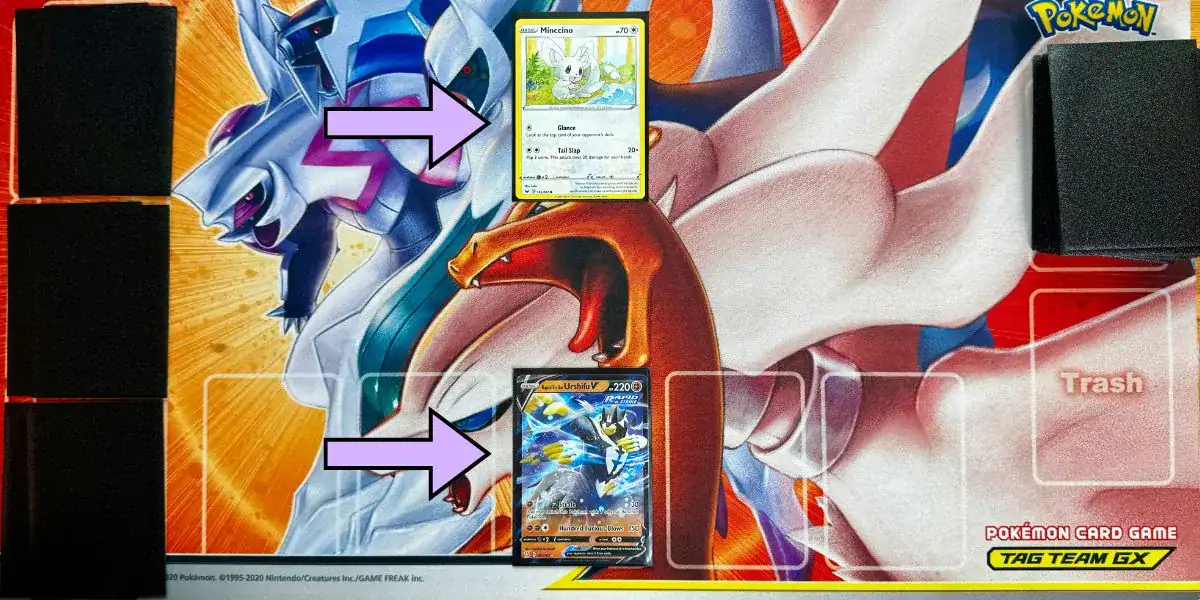
This signals the start of the battle. Let the games begin.
Step 7: Draw A Card To Start Your Turn
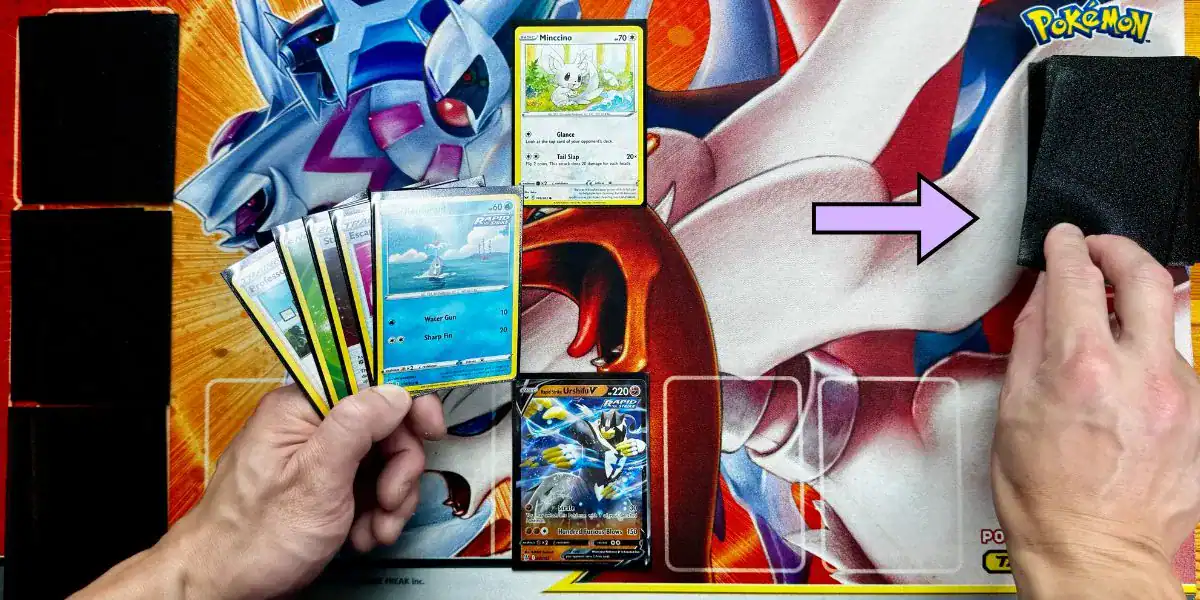
Drawing is the very first thing you do when your turn begins. This is called the Draw Phase, and you have to draw. Additionally, the player going first cannot play Supporter Trainer cards or attack. That’s just part of the turn rules in Pokémon TCG.
From this point onwards, you can perform steps 8 to 12 in any order.
Step 8: Attach An Energy
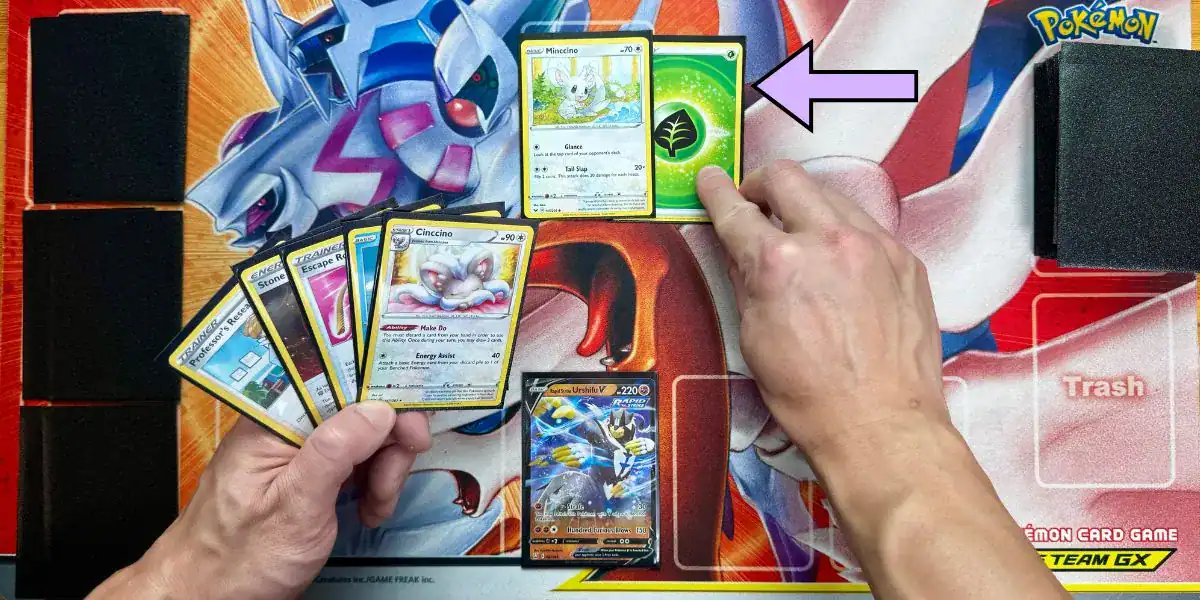
Attach one Energy card from your hand to any one of your Pokémon (if you have one in your hand). This is called your “free Energy attachment”, and it’s optional. This means you don’t have to attach Energy iif you don’t want to. But Energy is used to fuel Pokémon attacks, so it’s always a good idea to attach when you can. Both players get one free Energy attachment per turn.
Step 9: Use Trainer Cards
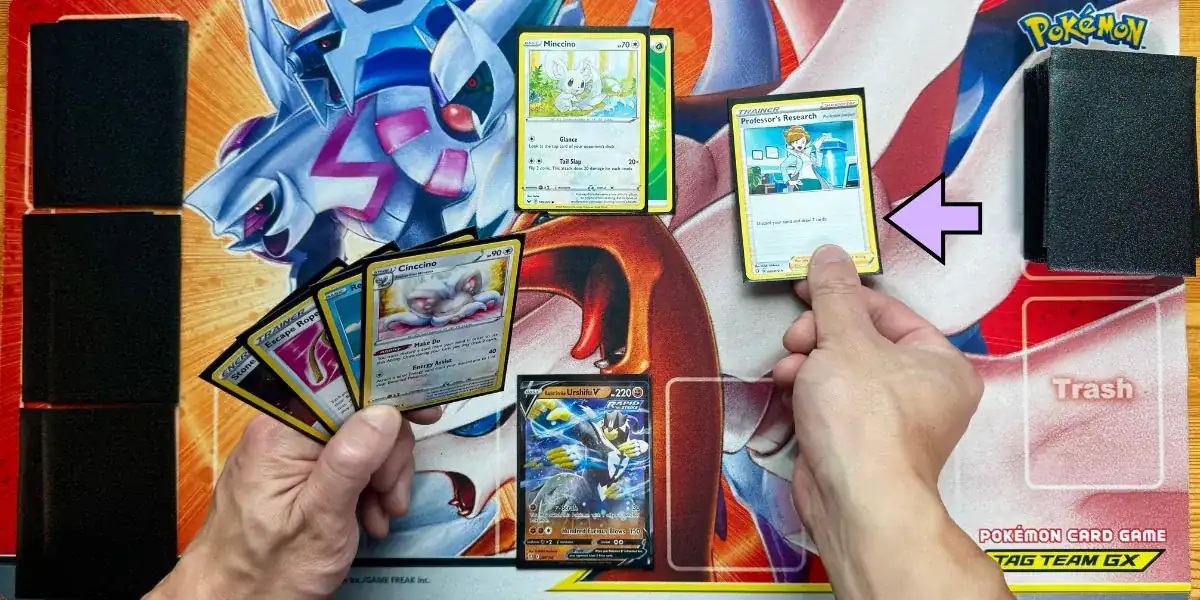
Trainers have a variety of effects that are always printed on the card. Read the card effect carefully and follow the instructions. Also, make sure you follow the respective rules for each category of Trainer.
Step 10: Bench Basic Pokémon & Evolve
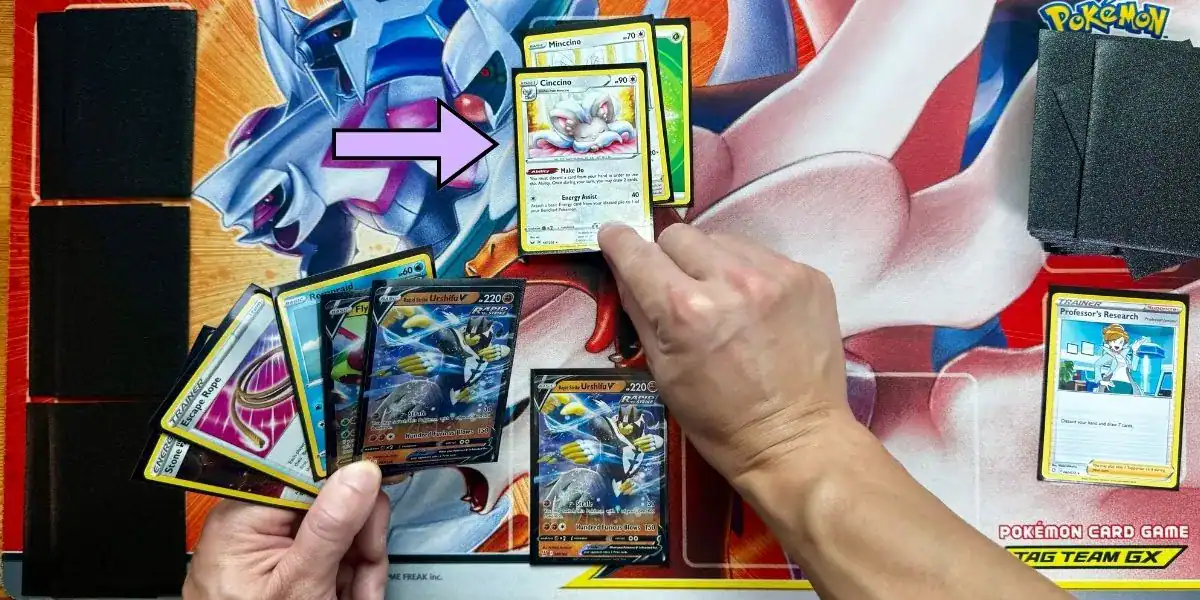
Got a Basic Pokémon in your hand? You can slap it onto the bench.
Many Pokémon can also evolve from their Basic forms into more powerful versions. You need to have the right evolution Pokémon in your hand to do this. And you can’t evolve the same Pokémon twice in one turn or evolve on the turn it was played. Learn about the essential rules for evolving in our Pokémon evolution guide.
Step 11: Activate Pokémon Abilities
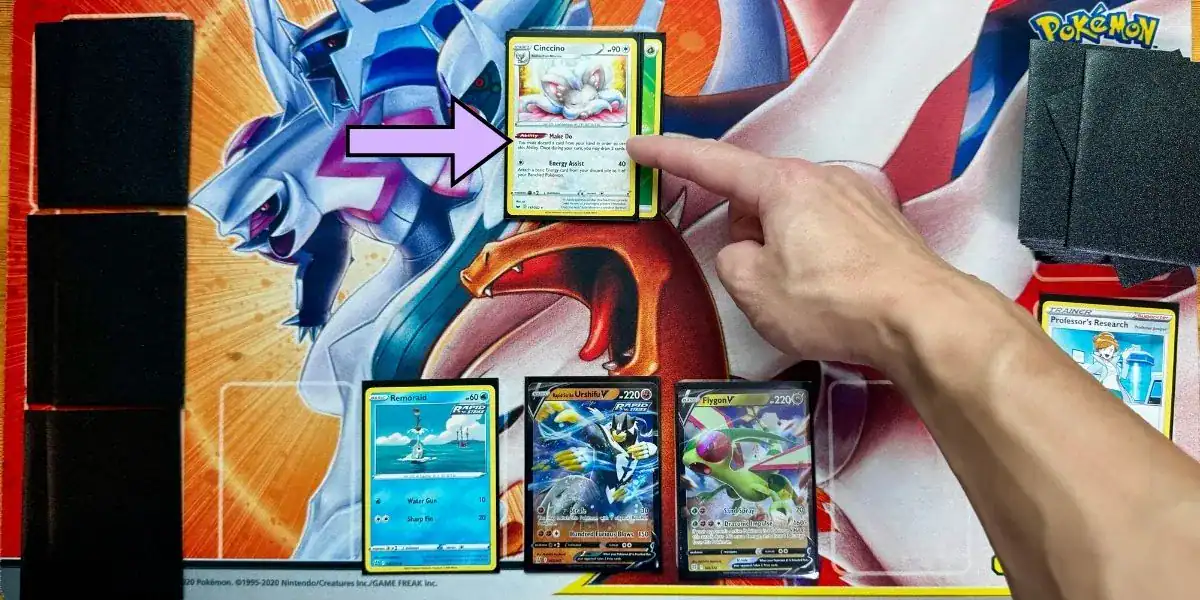
Some Pokémon cards have Ability effects printed below the artwork. These don’t count as attacks. This means they can be activated without using your attack for the turn. Learning how to use Abilities is how skilled players build combos and win battles.
Step 12: Retreat A Pokémon
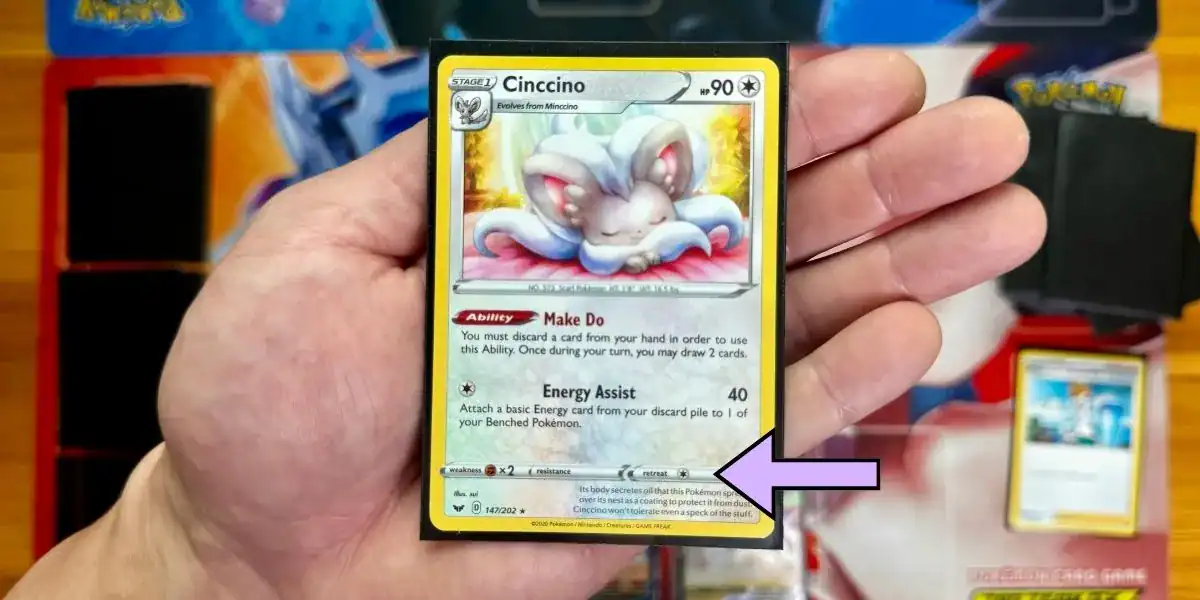
Retreating swaps your Active Pokémon with a Benched Pokémon. You can retreat a Pokémon by discarding its Retreat Cost in Energy cards (check the card’s bottom right). This is completely optional. If your Active Pokémon is close to being KO’d it may be a good idea to retreat it now to bring it back out later.
Step 13: Attack
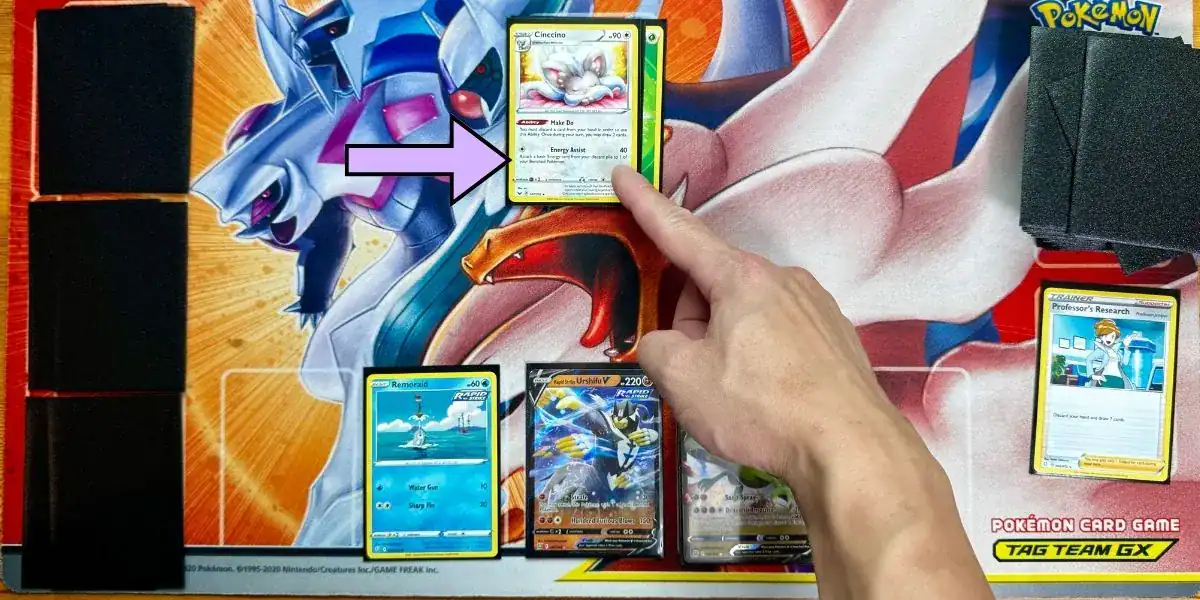
Now you’re ready to throw hands (or claws, or vines- whatever your Active Pokémon has going on). To attack, look at your Active Pokémon’s bottom half- the attack section. You’ll see:
- Energy cost.
- Attack name.
- Damage output.
- Attack effect.
Pokémon can only attack if they have the correct type and amount of Energy attached to match the attack’s Energy cost (the left-side colored circular symbols).
To resolve the attack, place the attack damage (if any) on your opponent’s Active Pokémon using damage counters (each counter = 10 damage).
If total damage meets or exceeds the defending Pokémon’s Hit Points, it’s knocked out- your opponent puts it into the discard pile, and you take a Prize card.
By the way, the rules for attacking are strict. Your turn is over once you attack- no going back. So make sure everything else is done first.
3 Ways To Win
There are 3 ways to win a Pokémon TCG battle:
1. Prize Victory
You take prize cards every time you knock out an opponent’s Pokémon. Most KOs are worth 1 prize. But Pokémon ex, V, and VSTAR are worth 2 prizes. Take all 6 prize cards before your opponent? You win.
2. Deck-Out
If your opponent tries to draw a card and their deck is empty, they immediately lose.
3. Bench-Out
If your opponent has no Pokémon left on the bench and their Active gets KO’d? Game over.
Special Conditions
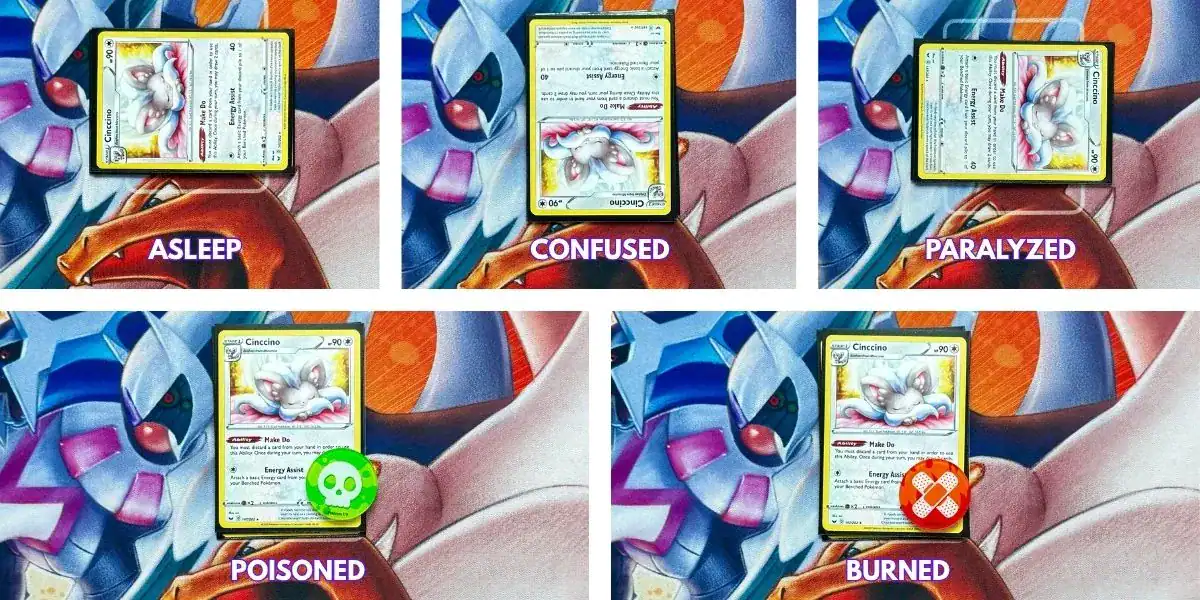
If you’ve ever played the Pokémon video games, you’ll know all about Special Conditions like Poision, Burn, etc. They exist in the TCG too.
Here’s how each Special Condition works:
- Poisoned: Place a Poison marker on the affected Pokémon. Put 10 damage on the Pokémon between turns.
- Burned: Place a Burn marker on the affected Pokémon. Flip a coin between turns; if tails, the Pokémon takes 20 damage. If heads, the burn heals.
- Asleep: Turn the Pokémon anti-clockwise. Asleep Pokémon cannot attack or retreat. Flip a coin between turns. If heads, the Pokémon wakes up. If tails, it remains asleep.
- Paralyzed: Turn the Pokémon clockwise. Paralyzed Pokémon can’t attack or retreat on their next turn. Paralysis heals after the next turn ends.
- Confused: Turn the Pokémon upside down. Flip a coin before attacking. If heads, the attack proceeds as normal. If tails, the confused Pokémon does 30 damage to itself.
That’s an overview of how it works. Check out our Special Conditions tutorial for a full explanation!
Beginner Pokémon TCG Mistakes
Think you know the rules? Here are some bad habits that beginners make that can cost easy wins. Let’s fix that now.
The most common beginner mistakes in Pokémon TCG:
- Running too few Basics in your deck. Mulligans galore. Run at least 10–15 Basic Pokémon to avoid drawing an unplayable opening hand.
- Forgetting to draw. Skipping your draw step is criminal.
- Misplaying Energy. Don’t drop your only Energy onto a benched Pokémon if your Active is getting pounded.
- Misreading card text. Every attack, Ability, and Trainer is different. Don’t assume. Read everything. Seriously.
- Skipping Abilities. You’d be shocked how often beginners ignore using Pokémon Abilities because they don’t know how they work.
- Not using sleeves. Cards get scuffed easily when you’re constantly shuffling them. Invest in a set of cheap card sleeves to keep them protected.
Building Your First Pokémon TCG Deck
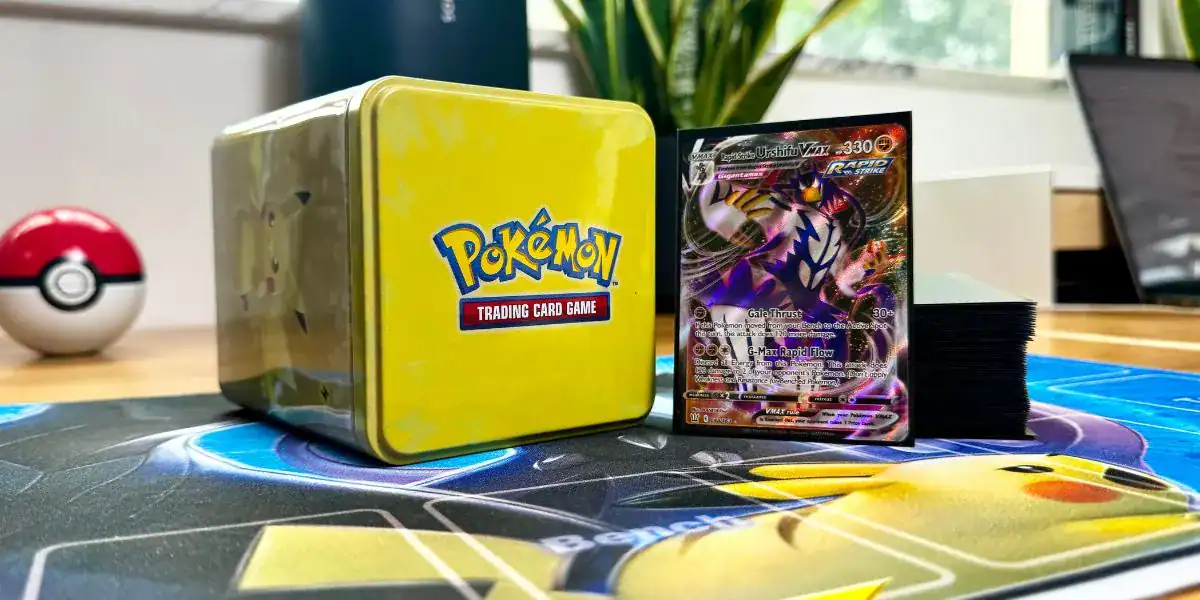
Here’s a secret most beginners don’t learn until they start losing to skilled players… a lot:
Winning in Pokémon TCG doesn’t happen by just choosing your favourite Pokémon. It happens by building a deck of 60 cards that all work together to help you set up fast and attack hard…it’s called deck synergy. It begins by choosing the right number of Pokémon, Trainers, and Energy.
Here’s an overview of how to build a Pokémon deck for beginners:
| Card Type | Recommended Number | Tip |
|---|---|---|
| Pokémon | 15 to 25 | Aim for 10 to 15 Basic Pokémon and 5 to 10 evolutions. Avoid loading up more than 3 copies of Stage 2 evolutions (they’re slow to set up). |
| Energy | 10 to 15 | Based on how Energy-hungry your attacks are. Some decks run fewer; some need more. |
| Trainers | 15 to 25 | 10 to 12 Item cards, 4 to 6 Supporter cards, 2 to 4 Stadiums. Focus on draw, search, and disruption cards. |
Ready to turbocharge your deck? Level up with our complete deck-building guide.
Entering Your First Tournament
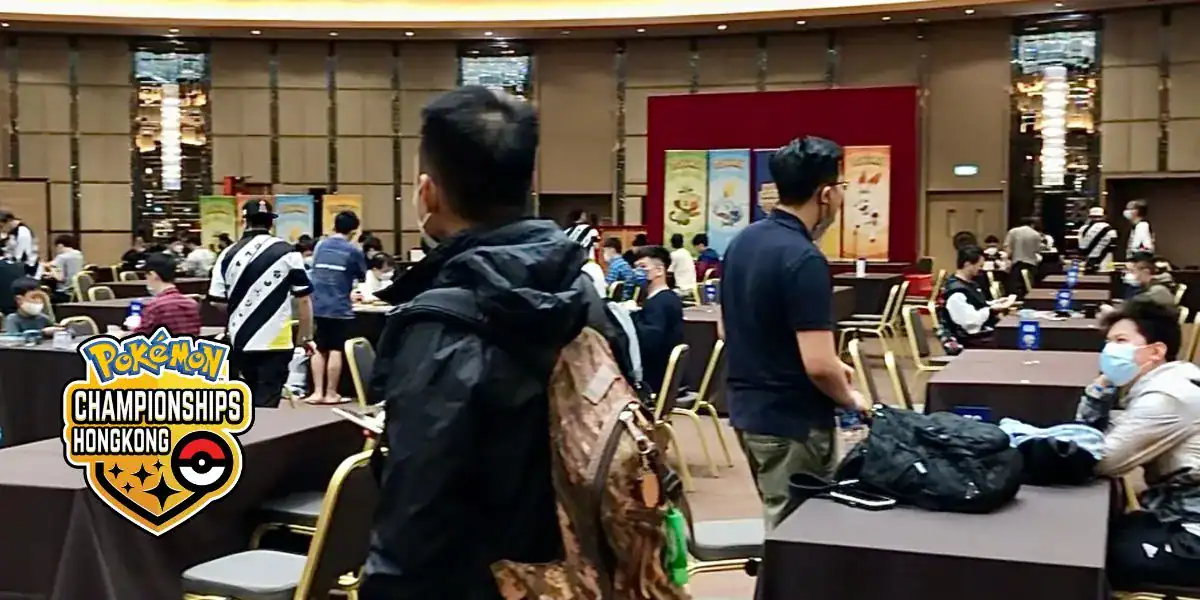
Alrighty. You’ve learnt how to play the Pokémon card game and you’ve built your first deck. What now?
For serious players, competitive Pokémon TCG is where it’s at. You build your deck, find a competitive event, and battle other players round by round. If you’re good? You might make it to the World Championships for a chance to be crowned Pokémon Master.
What to bring:
- Standard Format 60-card deck. Check those regulation marks!)
- Decklist. Use the Official decklist template.
- Card sleeves. Keep every card uniform and fair. Scuffed cards are deemed as “marked” and can result in Judge calls.
- Playmat. Optional, but looks pro and protects your cards.
What to Expect:
- Most events follow the Swiss format. You play 3–5 matches. Each match is usually best-of-one in the early stages or best-of-three in the latter stages. Players with the highest number of wins move on to the knockout rounds until a winner is declared.
- A mix of players. Some pros, some kids, some dads with championship playmats and a terrible deck. Don’t sweat it. Enjoy it.
- Prizes. Including promo cards, booster packs, playmats, and points to progress into higher competitions.
Learn Faster With Pokémon TCG Live
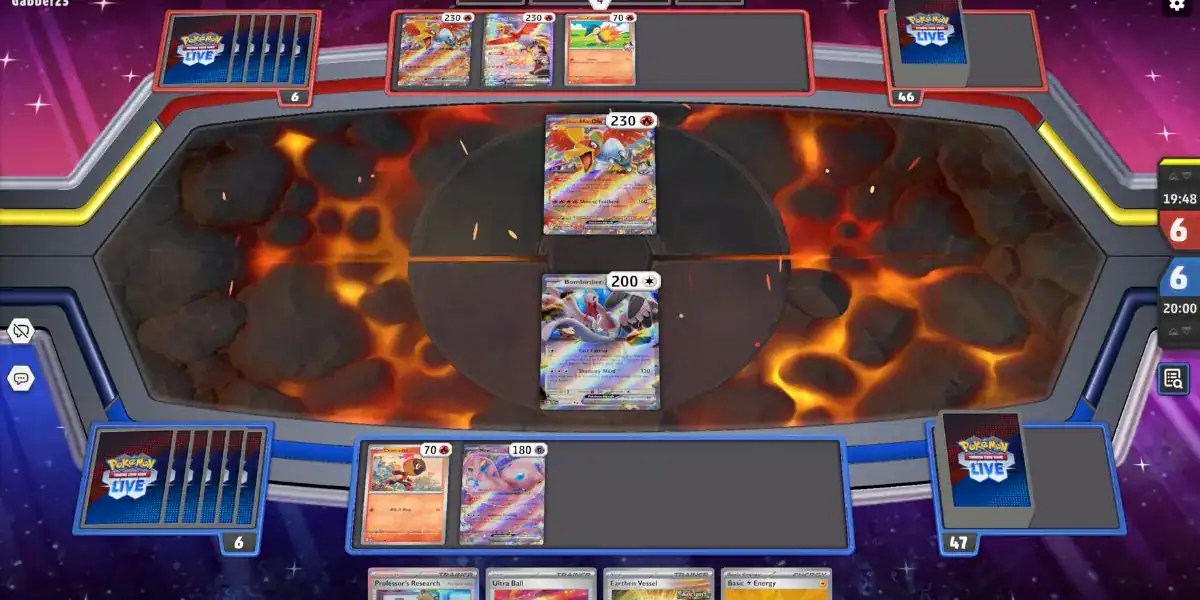
Still fumbling with your cards and forgetting which rule applies when? Don’t worry- it’s normal. Pokémon TCG has a learning curve.
That’s where Pokémon TCG Live (PTCGL) comes in. It’s a digital version of the real-life Pokémon card game. PTCGL is a great way for beginners to learn the real-life game. Here’s why:
- Interactive tutorials guide you through the basics of how to play the Pokémon TCG. You get to play through the battle mechanics and learn how the game works.
- PTCG rules are enforced automatically through in-game cues. Card draws happen on their own, special condition damage is applied for you, and if you’ve already played a Supporter, the game won’t let you play another that turn. You simply can’t do anything that breaks the rules.
- Deck building is easy with the in-game card database. Experiment with different strategies and build decks without spending a cent on physical cards. The system also shows which cards are legal in the Current Format, so you’ll always know if your deck is competition-legal or not.
- Play with the hottest decks right out of the gate. The moment you open a new profile, you get access to starter decks that have been proven in recent tournaments. They’re packed with real meta cards and tested strategies. You’re not just learning the basics- you’re learning how to win.
And the best part? It’s free. You can try it now by creating your account at PTCGL.
Parents Guide To Playing Pokémon Cards
Let’s be honest- some of you are here learning how to play Pokémon cards because your kid is obsessed, wants to learn, and you just want to keep up. Major respect.
This game is totally family-friendly, and teaching it the right way can build attention, reading, critical thinking, strategy, and maths skills faster than you think.
Here’s how to make learning the Pokémon TCG less like a test and more like story time with battle phases.
Tips for teaching the basics to kids:
- Use simple language. Avoid jargon when you first start. Use simple terms like “Energy powers up your Pokémon.”, “You need to take a card every turn.”, “Put Pokémon on your Bench so they’re ready if your first one gets knocked out.”. Your child will learn the jargon naturally as they play the game more.
- Use visuals. This is where a playmat works wonders. All the essential zones are marked out; active position, bench, discard pile, etc. Playmats also feature unique artwork depicting a Pokémon scene, which adds to the engagement.
- Start small. Refer to the “How to Play Pokémon TCG Overview” section at the top of this article for a simplified version of the game. It explains all the bare-bones essentials to get started. Focus on drawing, energy attachment, playing trainers, and attacking. Don’t over-explain retreat rules, special conditions, or evolution on day one. You’ll learn naturally with practice.
- Encourage them to explain things. Ask them, “Can you show me your favorite Pokémon and tell me what it does?”. That not only boosts comprehension but also makes the game feel like a cool secret they know.
- Teach caution. Alright. Here’s the darker side of Pokémon TCG- playground scams do happen. Some Pokémon cards (not all) are “rare” and valuable, and kids definitely know this. Take it from me- I once traded my shiny Blastoise for a stack of cheap commons. Thought I was getting a great deal at the time. Spoiler: I wasn’t. It still haunts me.
Need more help? There are Pokémon Parents’ Guides out there- made by other parents like you who dove into the cardboard chaos and survived.
Playing Vs Collecting
Not everyone gets into Pokémon for the same reason. Some folks love the thrill of playingm, while others just want to collect shiny cards and flex their binder.
Let’s break down both sides of the hobby so you can decide your vibe, or balance both.
Playing the Pokémon Cards:
- You care about strategy, combos, tempo, and tournament legality.
- You buy cards for their function: Energies, Trainers, and attackers with strong effects.
- Your deck is sleeved, tested, and optimized for real matches.
Collecting Pokémon Cards:
- You chase holos, secret rares, alt-arts, and vintage sets.
- You don’t care if the card is playable, as long as it’s pretty and valuable.
- You might grade your cards to increase value or keep them sealed in binders.
- You’re investing in aesthetics, nostalgia, and potential value.
Combination:
Playing and collecting aren’t mutually exclusive. They’re just two sides of the Pokémon TCG. Most people in this hobby do both. Some players collect cards casually between tournaments, whilst some collectors dabble in playing the game.
This guide has taught you how to play Pokémon cards. Now you may be interested in our Pokémon card collecting guide.
Conclusion
If you’ve made it this far, you now know more about how to play Pokémon cards than 90% of casual beginners. You’ve learned how to serup the game, navigate turn actions, build your deck, avoid rookie mistakes, and even join tournaments without feeling out of place.
Whether you’re just playing at home, teaching your kid, or building your first Standard-legal tournament deck, this game has space for you. And if you ever feel overwhelmed, just reach out to us!
So sleeve up, draw a card, and always- level up.
FAQ
Kalam is a PTCG gameplay expert and content creator. He started playing and collecting Pokémon cards since 1996. When he’s not working, you can find him nerding out on Anime!
Ready To Level Up At PTCG?

